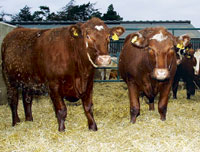Finishing cattle over 30 months is mostly less efficient

Changes to the over-30-month rule in 2006 may have removed the urgency to finish cattle earlier, but beef farmers need to be careful to avoid age creep, according to EBLEX’s Mark Topliff.
“Beef producers must be careful to avoid age creep in their finishing animals if they are to maximise both productivity and beef quality,” warns Mr Topliff following analysis of the latest BCMS slaughter data.
BCMS records show since changes to the over-30-month rule in 2006, the number of beef cattle being slaughtered over 30 months of age has more than doubled, with the proportion of 30-36 month olds in the prime cattle slaughter mix having risen from 2.4% in 2006 to nearly 6% in the past year.
And while it is reasonable practice to keep animals a little longer to achieve the correct level of finish, Mr Topliff stresses that marketing stock at less than 30 months offers the greatest benefit.
“Marketing stock at less than 30 months and preferably between 18 and 24 months offers the greatest economic and environmental efficiency in most cases. There are no breeds or crosses routinely used in England that can’t make a market specification at this age when fed sufficiently well,” he adds.
And finishing cattle over 30 months is known to be costly in terms of feed resource as larger animals require a higher proportion for their daily intake for maintenance, adds Mr Topliff. “Older stock also present an increased risk of both over-fatness and over-weight penalties, with eating quality also thought to decline with the build-up of connective tissue,” he says.
Data from Quality Meat Scotland also show the number of male cattle being slaughtered between 30 and 36 months has doubled over the past couple of years, although QMS’s Stuart Ashworth warns it shouldn’t be taken out of line with the base level.
“Although in 2009 there were 21,600 male cattle killed between 30 and 36 months compared to 18,868 male cattle in 2008, set against the entirety of it most animals are still killed under 30 months of age. “Thirty months is now not critical because there isn’t the penalty in terms of age. This explains why more cattle are being slaughtered after 30 months.”
And for some farmers, finishing over 30 months can be beneficial. “For a low-cost, grass-based system with a slow maturing native breed, they may simply be finishing the animal on its natural profile to produce the best quality meat.”
However, Mr Ashworth says in most cases finishing under 30 months would be beneficial. “It would be better to sell younger because there are productivity and technical efficiency gains from finishing cattle earlier, as well as benefits to the environment in terms of greenhouse gas emissions. Cost of production versus revenue is the equation farmers need to keep in their head when calculating whether keeping cattle longer is efficient.”
